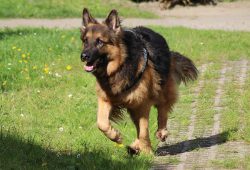The German Shepherd is a breed of medium to large-sized working dog that originated in [wiki base=”EN”]Germany[/wiki]. The breed’s officially recognized name is German Shepherd Dog in the English language (sometimes abbreviated as GSD). The breed is also known as the Alsatian in Britain and Ireland. The German Shepherd is a relatively new breed of dog, with their origin dating to 1899. As part of the Herding Group, German Shepherds are working dogs developed originally for herding sheep. Since that time however, because of their strength, intelligence, trainability, and obedience, German Shepherds around the world are often the preferred breed for many types of work, including disability assistance, search-and-rescue, police and military roles, and even acting. The German Shepherd is the second-most registered breed by the American Kennel Club and fourth-most registered breed by The Kennel Club in the United Kingdom.
Description
German Shepherds are medium to large-sized dogs. The breed standard height at the withers is 60–65 cm (24–26 in) for males and 55–60 cm (22–24 in) for females. The weight standard is 30–40 kilograms (66–88 lb) for males and 22–32 kilograms (49–71 lb) for females. They have a domed forehead, a long square-cut muzzle with strong jaws and a black nose. The eyes are medium-sized and brown with a lively, intelligent and self-assured look. The ears are large and stand erect, open at the front and parallel, but they often are pulled back during movement. They have a long neck, which is raised when excited and lowered when moving at a fast pace. The tail is bushy and reaches to the hock.
Intelligence
German Shepherds were bred specifically for their intelligence, a trait for which they are now famous. In the book The Intelligence of Dogs, author [wiki title=”Stanley_Coren” base=”EN”]Stanley Coren[/wiki] ranked the breed third for intelligence, behind Border Collies and Poodles. He found that they had the ability to learn simple tasks after only five repetitions and obeyed the first command given 95% of the time. Coupled with their strength, this trait makes the breed desirable as police, guard and search and rescue dogs, as they are able to quickly learn various tasks and interpret instructions better than other breeds.
Temperament
German Shepherds are moderately active dogs and are described in breed standards as self-assured. The breed is marked by a willingness to learn and an eagerness to have a purpose. They are curious, which makes them excellent guard dogs and suitable for search missions. They can become over-protective of their family and territory, especially if not socialized correctly. They are not inclined to become immediate friends with strangers. German Shepherds are highly intelligent and obedient, as well as being protective of their owners.
Health
Many common ailments of the German Shepherds are a result of the inbreeding practiced early in the breed’s life (although this was necessary to preserve other traits for the breed). One such common ailment is hip and [wiki title=”Elbow_dysplasia” base=”EN”]elbow dysplasia[/wiki] which may lead to the dog experiencing pain in later life and may cause [wiki title=”Arthritis” base=”EN”]arthritis[/wiki]. A study conducted by the University of Zurich found that 45% of the police working dogs were affected by degenerative spinal stenosis, although the sample studied was small. The Orthopedic Foundation for Animals found that 19.1% of German Shepherd are affected by hip dysplasia. Due to the large and open nature of their ears, German Shepherds are not prone to ear infections because there is no hair in the [wiki title=”Ear_canal” base=”EN”]outer ear canal[/wiki] to hold debris or moisture. According to a recent survey in the UK, the median life span of German Shepherds is 10.95 years, which is normal for a dog of their size.
[wiki title=”Canine_degenerative_myelopathy” base=”EN”]Degenerative myelopathy[/wiki], a neurological disease, occurs with enough regularity specifically in the breed to suggest that the breed is predisposed to it. A very inexpensive DNA saliva test is now available to screen for degenerative myelopathy. The test screens for the mutated gene that has been seen in dogs with degenerative myelopathy. A small study in the UK showed 16% of young asymptomatic GSDs to be homozygous for the mutation, with a further 38% being carriers. Now that a test is available the disease can be bred out of breeds with a high preponderance. The test is only recommended for predisposed breeds, but can be performed on DNA from any dog on samples collected through swabbing the inside of the animal’s cheek with a sterile cotton swab. Now that there is a test available, prospective German Shepherd buyers can request the test from the breeder or buy from a breeder known to test their dogs.
German Shepherd. (2017, July 7). In Wikipedia, The Free Encyclopedia. Retrieved from https://en.wikipedia.org/w/index.php?title=German_Shepherd&oldid=789393468


